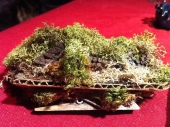David and Matt, thank you for your time on Permies! The first I've heard of your book was from Paul's daily-ish email. I recently met a retired bee inspector who gave me some advice about keeping bees. She told me after inspecting thousands of hives she can now tell exactly what's wrong with a hive just by putting an ear up to the side and smelling it when approaching. She said large triple deep hives and 'free comb' is the key to success around here, which is Northeast Ohio, Zone 6a. She recommended three deep hive bodies for the brood chamber, with bars only across the top deep hive body. She said the bees build the comb down to the bottom eventually, and it is much more productive for them to work on large smooth pieces of comb. She called this method 'free comb'. It makes sense to me and seems more natural for the bees, a real Permaculture practice. She said the brood area is not to be opened and the less you disturb them the better. Even using the smoker is a great disturbance for bees and sets them back. She stressed her views on observing nature and a hands off approach. I believe she only harvests honey. I tend to put faith in this woman's observations and want to give it a try. I'm curious if you have any knowledge or experience on this method.
Thanks,
-Galen



